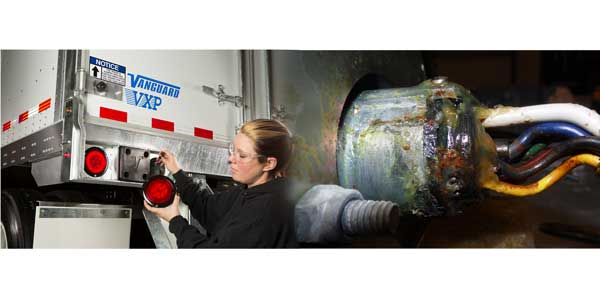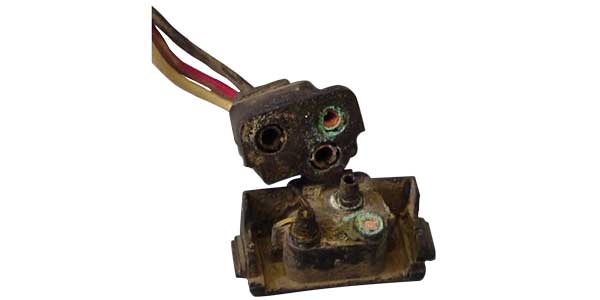“Corrosion-causing moisture is always present and any breach in integrity enables it to invade an electrical system,” says Brett Johnson, president and chief executive officer of Optronics International. “When connections aren’t maintained, not only can it mean an early death for that particular component, it can mean that the entire system may be in jeopardy.”
Electrical system components on trailers most subject to corrosion include all non-sealed connectors and any exposed connections, notes Mark Assenmacher, director of marketing at Peterson Manufacturing Co. “Corrosion can add to costs for maintenance, which includes replacement parts and labor. Plus, there’s the additional downtime when units are sitting, and there are costs associated with potential CSA violations.”
Andrew Liuzzo, marketing communications specialist at Truck-Lite, says that electrical system component corrosion often starts at improper lighting and harness connections. “The best connections are formed by sealed connectors, which ensure that the connector is fully engaged and protected from road spray,” he says. “Sealed locking connectors resist corrosion by blocking out moisture and debris to ensure airtight and highly conductive connections.”
The first step
At Phillips Industries, Marketing Manager Megan Vincent points out that electrical connectors at the front of a trailer are typically the first to show signs of corrosion. “There is maximum current flow at that location, and moisture paired with power current is the first step in building corrosion,” she says.
“The front of the trailer is also exposed to road contaminants being kicked up due to the tractor tire spray, which combined with rain can create a vacuum so the spray finds its way inside exposed areas,” Vincent explains. “Other areas on the trailer to watch for corrosion buildup are in the harness system, at lighting connectors, and on exterior lights.
“The cost of corrosion can be very significant,” she adds. “You’re lucky to get away with simply replacing the socket and several inches of electrical wiring at the front of the trailer. However, depending on the severity of the corrosion, the trailer may need an entire new harness system. Overall, you’re looking at repair or replacement costs, including labor, downtime and possibly fines.”
Harness parts that have an inferior design or are improperly installed, incompatible plugs and lamps, and modifications made to a sealed system can all lead to corrosion, points out Kent Bode, director of OEM sales at Grote Industries. “Connections in high spray areas, and connectors where the wires are bent close to the back of the connector opening up a gap in the seal can allow water ingress,” he says.
“There can be subsequent failures of other parts as corrosion travels through system,” Bode adds. “Downtime of equipment, repair costs on the road, and even repairs that lead to further ingress of water and corrosion can be even more costly.”
The weather factor
“Industry professionals may think of corrosion as more of a cold weather problem,” says Optronics’ Johnson. “But for every 50-degree rise in temperature, the rate of corrosion doubles, so the summer months can actually be very hard on a vehicle’s electrical system. Temperature extremes can also attack a system where you can’t see it.
“Chemicals and salts used to treat icy road surfaces often accumulate on the components of a vehicle’s electrical system, and have an adverse impact,” Johnson adds. “Unfortunately, while making the roads safer, the anti-icing chemicals and salts become aerosolized as road spray coats the harness system that is largely exposed on an trailer. That enables the airborne substances to reach lighting and electrical components in areas of the trailer that are much higher.”
While trailer OEMs have heavily invested in the design of sealed weather resistant harness assemblies, by doing so they have also made lots of connections that need to be properly inspected and maintained, says Larry Rambeaux, application engineer at Purkey’s Fleet Electric. “While a quality connector is well sealed, none are 100% weather-proof if not properly mated or maintained,” he adds. “This could be that they are not properly mated when the trailer is built, inspected while in service or damaged during their service life.
“The biggest issues we see are improper repairs to wires that result in repeated failures,” Rambeaux continues. “Many of these repairs are done using terminals or splices that allow corrosion to happen at an accelerated rate and lead to further damage that may even require that an entire harness be replaced.”
Fix it right
The best recommendation Rambeaux offers fleets is to take the time to fix it right the first time.
“With the corrosion issues fleets are faced with today, electrical repairs should always be done with sealed terminals,” he says. “We recommend the use of bare terminals that are protected by quality dual wall heat shrink that utilizes some sort of sealing compound to make them truly weatherproof.”
Fleets can help prevent corrosion or mitigate its damage to trailer electrical components by keeping non-sealed electrical connections generously coated with high quality dielectric grease, notes Peterson’s Assenmacher.
“Always consistently inspect electrical components and harnesses for damage, breached insulation and exposed wiring,” he adds, “and always protect harness components with properly installed grommets wherever wiring passes through openings.
“Use split or corrugated loom to prevent chafing and cuts, and tie all harness wiring to properly secure it,” Assenmacher adds. “Also, keep wiring away from sharp edges and corners, and never puncture wiring insulation with a probe-type circuit tester.”
“Throw away every probe tester to ensure that maintenance personnel do not penetrate wires to test for continuity,” Grote’s Bode says, “and don’t ever cut and splice into the system. The key is to not open the system to any water intrusion.”
Any time a connection is disconnected, clear the debris and dirt from the connection and use the proper amount of grease when reconnecting, Bode recommends. In addition, ensure that harnesses are properly secured and grommets are used whenever a wire or cable goes through a hole in metal to prevent abrasion and cutting of wires, as that also opens a path for water ingress and potential shorts.
Inside out
“Fleets can prevent or mitigate corrosion damage by using a dielectric compound or spray on all electrical connections to protect against moisture and debris,” Truck-Lite’s Liuzzo says. “Fleets should also immediately stop using any wire probes to test system voltage or continuity. Piercing the wire with a probe will allow moisture to run through the harness, corroding the system from the inside out.”
Phillips’ Vincent says that one reason it’s important to make sure there are proper seals at all connections is because water and moisture can be physically pulled through the copper wiring.
“It is rather inexpensive to clean connections regularly using a plug and socket cleaning brush, and to apply dielectric grease to dry connections before reconnecting,” she says. “For the harness and wiring components, it’s important to never pierce the electrical wiring to test continuity. This creates a hole in the jacketing which will cause corrosion in the system.”
All manufacturers recommend that fleets implement regular inspection and maintenance schedules for trailer electrical and lighting systems. Additionally, they each offer a range of products that can help avoid costly corrosion.
“Trailer electrical harness and lighting system components, when properly designed, should never have to be replaced,” says Truck-Lite’s Liuzzo. “Fleets can significantly reduce their corrosion exposure by working with their OEM and lighting manufacturer as they develop vehicle specifications.”
Read more on trailers from Fleet Equipment‘s latest issue: from doors, lift gates and floors to lighting to trailer tires.















